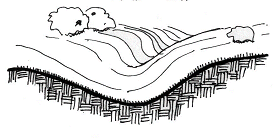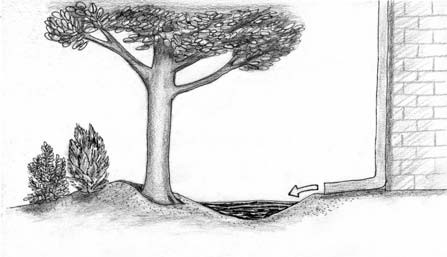 |
SWALES
 |
You know it when you see one!
|
Swales are
simply shallow, low depressions in the ground designed to
encourage the accumulation of rain during storms and hold it for a few
hours or days to let it infiltrate into the soil.

Swales
ideally are tree-lined and store wa  ter for ter for
the immediate landscape as well as help cleanse
the water as it percolates down. Swales can be
installed separately or as part of a larger water rain catchment system
with other water conservation measures.

Swales on slight slopes can
also be used to direct water away into percolation pits that will
charge the groundwater.
Swales
dug into even the gentlest of slopes will fill with water after every
good rain and allow the moisture to percolate deep into the soil over a
day or more. This charges the subsoil over several years allowing the
trees planted into the mound to thrive even during the driest of times.
Also
known as infiltration swales, biofilters, grassed swales,
or in-line biorentention, bioswales are vegetated
open channels specifically designed to attenuate and treat stormwater
runoff for a defined water volume. Like open ditches, they convey
larger stormwater volumes from a source to a discharge point, but
unlike ditches, they intentionally promote slowing, cleansing and
infiltration along the way.
|
Grassed
Channels
These
are similar to a conventional drainage ditch, with the major
differences being flatter side slopes and longitudinal slopes, and a
slower design velocity for water quality treatment of small storm
events. Grass channels are the least expensive option.
Grass
channels should be designed to ensure that runoff takes an average of
ten minutes to flow from the top to the bottom of the channel.

|
Wet Swales
These
swales intersect the groundwater, and behave almost like a linear
wetland cell. The design variation incorporates a shallow
permanent pool and wetland vegetation to provide stormwater
treatment. Wet swales are rarely used in residential settings because
the shallow standing water is often unpopular with homeowners.
What are the benefits of
using swales?
- Improves
water quality
- Cheaper to
construct than piped systems
- Can be
incorporated into the landscape
- Low maintenance
- Visible
Operation
|
Dry
Swales
Dry
swales incorporate a deep fabricated soil bed into the bottom of the
channel. Existing soils are replaced with a sand/soil mix that meets
minimum permeability requirements. An underdrain system is also placed
under the soil bed. Typically, the underdrain consists of a layer of
gravel encasing a perforated pipe. Stormwater treated by the soil bed
flows into the underdrain, which conveys treated stormwater back to the
storm drain system.

|
 |
What makes a good swale?
- The longer the
swale the better. A long and a winding swale allows plenty of time for
settlement of solids contained in the runoff. Swales of more than 70m
in length give good, consistent performance.
- No sharp corners. Swales should
have gentle curves.
- Shallow gradients. A swale which
curves to and fro with a shallow gradient is better than a swale which
is built directly down slope.
- Shallow swales with no permanent
water have better chance of establishing a grass sward.
- Swales work better when used in
conjunction with other filtration techniques like recharge pits,
recharge trenches etc.
|
|

Design
Considerations
Factors to be kept in
mind while constructing swales:
Soils
- Soil
infiltration rates between 0.5 and 3.0 inches per hour are preferred.
- The
clay content of the soil should be less than 20 percent, and the
silt/clay content should be less than 40 percent.
- Coarse,
highly permeable soils should be avoided because they have shorter
infiltration times and are less conducive to supporting growth of
vegetation.
- Impermeable
soils facilitate ponding and should be avoided.
- The
bottom of the swale should be at a minimum of two feet above the
seasonal water table or bedrock.
- Less
desirable soils can be amended to improve infiltration characteristics.
Cross Section Shape
- Parabolic
or trapezoidal cross sections maximize infiltration.
- Triangular
cross sections should be avoided as they concentrate flow and promote
channel erosion.
- Side
slopes should be relatively flat (3:1 or flatter).
- Channel
bottom width should be between two feet and eight feet (based on
cross-sectional area of flow for the channel).
Slopes and Swale
Length
- Swale
gradients (slopes) of one to two percent are recommended. Gradient
pictures
- Swale
length should be a minimum of 200 feet to encourage deposition.
Vegetative
Cover
- Vegetation
should be limited to perennial grasses and grass-legume mixes.
- Species
of vegetation chosen should have a dense growth habit and be able to
tolerate extended periods of flooding.
- Vegetative
species can be selected to target different types of pollutants.
- Vegetation
height should be maintained at a minimum height of three to four inches.
Design
Calculations
- Typical
storm intensities should be calculated for each specific site location.
- Swale
design should be based on flow rate, not volume. Runoff should pass
from the upstream end to the downstream end of the swale in ten minutes.
- Swale
should be designed to effectively handle runoff from a one-inch,
24-hour storm event and efficiently pass excess runoff from larger
storms (e.g., 10-year storm events).
Where should the swale be located?
 This
will depend on the layout of the site and the amount of space
available, but the swale would usually run either parallel with or at
90° to the houses, with the hard-standing draining towards the swale. This
will depend on the layout of the site and the amount of space
available, but the swale would usually run either parallel with or at
90° to the houses, with the hard-standing draining towards the swale.
Roof
water can be directed to the swale via surface drains or via smaller
swales.
They
can also be constructed to drain areas which flood or hold water for a
long time. This water can be directed into a recharge pit that could
charge the ground water.
Where
swales should NOT be located ?
Swales
and other stormwater infiltration systems should not be used in
areas
where the land around which drains the water into the system is
associated with or used for chemical storage, high levels of
pesticides, the washing and maintenance of vehicles or equipment, or
where wastes are handled.
They also
have to carefully used near petrol bunks, garages, mechanic sheds etc.
and other areas where oils, grease, and other types of toxic materials
can get into the groundwater.  | "I am having a swale of a time ..." |
|
|
 |

 ter for
ter for 






 This
will depend on the layout of the site and the amount of space
available, but the swale would usually run either parallel with or at
90° to the houses, with the hard-standing draining towards the swale.
This
will depend on the layout of the site and the amount of space
available, but the swale would usually run either parallel with or at
90° to the houses, with the hard-standing draining towards the swale.